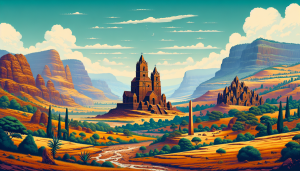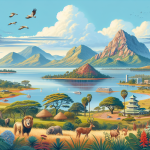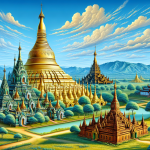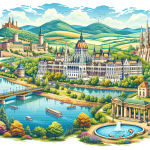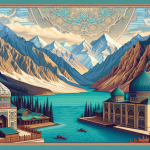Exploring the Enigmatic Beauty of Ethiopia: A Traveler’s Guide
Ethiopia, a country steeped in ancient history and rich cultural heritage, offers an unparalleled travel experience for those who seek adventure, history, and natural beauty. Nestled in the Horn of Africa, Ethiopia is a land of contrasts, where arid deserts meet lush highlands, and historical ruins stand beside bustling modern cities. This diverse nation is known for its unique cultural tapestry, which includes over 80 ethnic groups, each with its own language, traditions, and customs. From the rock-hewn churches of Lalibela to the vibrant streets of Addis Ababa, Ethiopia promises a journey that is as enlightening as it is exhilarating. Whether you’re an avid historian, a nature enthusiast, or a cultural explorer, Ethiopia’s myriad attractions will captivate your imagination and leave you yearning for more. In this comprehensive guide, we’ll delve into the must-see destinations, the rich history, and the cultural experiences that make Ethiopia a top travel destination.
Historical Wonders of Ethiopia
Ethiopia’s history stretches back thousands of years, making it one of the oldest nations in the world. Its historical significance is evident in the numerous ancient sites scattered throughout the country. For history buffs, Ethiopia offers a treasure trove of ancient wonders waiting to be explored.
The Rock-Hewn Churches of Lalibela
No visit to Ethiopia would be complete without a trip to Lalibela, home to the famous rock-hewn churches. Carved directly into the rock in the 12th century, these eleven monolithic churches are a testament to the architectural ingenuity and religious devotion of the Ethiopian people. Each church is unique in design and layout, and collectively, they form a labyrinthine complex that has earned Lalibela a place on the UNESCO World Heritage list. The most famous of these is the Church of Saint George, with its iconic cross-shaped design. Visitors can wander through the narrow passageways and tunnels that connect the churches, marveling at the intricate carvings and frescoes that adorn the walls.
Axum: The Ancient City of Legends
Axum, once the capital of the Aksumite Empire, is another must-visit destination for history enthusiasts. This ancient city is believed to be the resting place of the Ark of the Covenant, housed within the Church of Our Lady Mary of Zion. Axum is also renowned for its towering obelisks, some of which date back to the 4th century. The Great Stelae, the tallest standing obelisk, is a remarkable example of Aksumite engineering and artistry. Visitors to Axum can also explore the Queen of Sheba’s Palace, believed to be the royal residence of the legendary queen who played a significant role in Ethiopian history.
Gondar: The Camelot of Africa
Gondar, often referred to as the “Camelot of Africa,” is a city steeped in royal history. Founded in the 17th century by Emperor Fasilides, Gondar served as the imperial capital for over two centuries. The city’s most famous landmark is the Fasil Ghebbi, a fortress-like complex that includes several castles and palaces. The architecture of these structures reflects a blend of Ethiopian, Portuguese, and Indian influences, creating a unique and fascinating aesthetic. The Debre Berhan Selassie Church, with its beautifully painted ceiling depicting angels, is another highlight of Gondar. Visitors can also explore the nearby Fasilides’ Bath, a large pool used for the annual Timkat (Epiphany) celebrations, where thousands gather to witness the reenactment of Jesus’ baptism.
Natural Wonders of Ethiopia
Beyond its historical sites, Ethiopia boasts a diverse and stunning natural landscape. From the rugged Simien Mountains to the otherworldly Danakil Depression, the country’s natural beauty offers endless opportunities for exploration and adventure.
The Simien Mountains National Park
The Simien Mountains National Park, a UNESCO World Heritage site, is a haven for trekkers and nature lovers. The park is home to some of Africa’s highest peaks, including Ras Dashen, the fourth highest mountain on the continent. The dramatic landscapes of the Simien Mountains, characterized by jagged peaks, deep valleys, and towering cliffs, provide breathtaking vistas at every turn. The park is also home to several endemic species, including the Ethiopian wolf, the Walia ibex, and the Gelada baboon. Trekking through the Simien Mountains offers a chance to witness these unique animals in their natural habitat while taking in the awe-inspiring scenery.
The Danakil Depression: Earth’s Hottest Place
The Danakil Depression, one of the lowest and hottest places on Earth, is an otherworldly landscape that must be seen to be believed. Located in the northeastern part of the country, this geological wonder is characterized by vast salt flats, active volcanoes, and colorful sulfur springs. The Erta Ale volcano, known as the “Smoking Mountain,” features a continuously active lava lake, making it a popular destination for adventurous travelers. Despite its harsh environment, the Danakil Depression is home to the Afar people, who have adapted to the extreme conditions and continue to mine salt from the area. Visiting the Danakil Depression offers a unique glimpse into one of the most inhospitable yet fascinating places on the planet.
Lake Tana and the Blue Nile Falls
Lake Tana, the largest lake in Ethiopia, is another natural gem worth exploring. The lake is dotted with numerous islands, many of which are home to ancient monasteries and churches. These religious sites, some dating back to the 14th century, offer a serene and spiritual experience for visitors. A boat trip on Lake Tana provides a chance to visit these islands and learn about their historical and religious significance. From Lake Tana, the Blue Nile River flows out and eventually plunges over a cliff to create the stunning Blue Nile Falls, also known as “Tis Abay” or “The Smoking Water.” The falls, especially during the rainy season, are a spectacular sight, with a curtain of water cascading down into the gorge below.
Cultural Experiences in Ethiopia
Beyond its historical and natural wonders, Ethiopia offers a rich cultural experience that is deeply rooted in its diverse ethnic heritage and traditions. Engaging with the local culture provides a deeper understanding of the country’s identity and way of life.
Festivals and Celebrations
Ethiopia’s calendar is filled with vibrant festivals and celebrations that reflect its religious and cultural diversity. One of the most important festivals is Timkat, the Ethiopian Orthodox celebration of Epiphany. Held in January, Timkat involves elaborate processions, colorful attire, and a reenactment of the baptism of Jesus in the Jordan River. Another significant festival is Meskel, celebrated in September, which commemorates the discovery of the True Cross by Saint Helena. The festival is marked by the lighting of large bonfires and joyous singing and dancing. Attending these festivals offers a firsthand experience of Ethiopia’s rich religious heritage and communal spirit.
Local Cuisine and Coffee Culture
No visit to Ethiopia would be complete without indulging in its unique and flavorful cuisine. Ethiopian food is characterized by the use of **injera**, a spongy flatbread made from teff flour, which serves as both a plate and a utensil. Various stews and dishes, such as **doro wat** (spicy chicken stew) and **kitfo** (minced raw beef), are served on injera, creating a communal dining experience. Ethiopian meals are often accompanied by **tej**, a traditional honey wine, or **tella**, a local beer. Additionally, Ethiopia is the birthplace of coffee, and its coffee culture is an integral part of daily life. The traditional **coffee ceremony**, where coffee beans are roasted, ground, and brewed in front of guests, is a ritualistic and social activity that showcases the country’s hospitality and reverence for coffee.
Traditional Music and Dance
Ethiopian music and dance are as diverse as its people, with each ethnic group having its own unique styles and traditions. Traditional music often features the use of instruments such as the **krar** (a lyre-like string instrument), the **masenqo** (a single-stringed fiddle), and the **kebero** (a type of drum). Dance is an integral part of Ethiopian culture, with each region having its own distinctive dances that are performed during festivals, weddings, and other celebrations. For example, the **eskista** dance, characterized by rhythmic shoulder movements, is popular among the Amhara and Tigray people. Experiencing traditional music and dance performances offers a lively and engaging insight into Ethiopia’s cultural diversity and artistic expression.
Practical Travel Tips for Visiting Ethiopia
Before embarking on your Ethiopian adventure, it’s essential to be well-prepared to ensure a smooth and enjoyable trip. Here are some practical tips to help you make the most of your visit to this captivating country.
Visa and Entry Requirements
Most travelers to Ethiopia will need a visa to enter the country. Tourist visas can be obtained in advance from Ethiopian embassies or consulates, or online through the **Ethiopian eVisa** system. It’s important to check the latest visa requirements and ensure that your passport is valid for at least six months from the date of entry. Upon arrival, travelers may be asked to provide proof of onward travel and sufficient funds for their stay.
Health and Safety
Health and safety are important considerations when traveling to Ethiopia. It’s recommended to consult with a healthcare professional before your trip to ensure you have the necessary vaccinations and medications. Common vaccinations include those for **yellow fever, hepatitis A and B, typhoid, and meningitis**. Malaria is prevalent in some regions, so taking **antimalarial medication** and using **mosquito repellent** are advisable. In terms of safety, while Ethiopia is generally safe for tourists, it’s wise to stay informed about the local situation and avoid areas with political unrest or security concerns. Traveling with a reputable guide or tour operator can enhance your safety and provide valuable insights into the local culture and customs.
Transportation and Accommodation
Ethiopia’s transportation options range from domestic flights to buses and private vehicles. **Ethiopian Airlines** offers an extensive network of domestic flights that connect major cities and tourist destinations, making it a convenient option for long-distance travel. Buses and minibuses are available for intercity travel, but they can be crowded and less reliable. Hiring a private vehicle with a driver is another option, especially for exploring remote areas. When it comes to accommodation, Ethiopia offers a range of options to suit different budgets. From luxury hotels in Addis Ababa to budget guesthouses and lodges in rural areas, there’s something for every traveler. Booking in advance, especially during peak travel seasons, is recommended to secure your preferred accommodation.
Conclusion: A Journey to Remember
Ethiopia is a land of wonders that beckons travelers with its rich history, stunning landscapes, and vibrant culture. Whether you’re exploring the ancient rock-hewn churches of Lalibela, trekking through the majestic Simien Mountains, or immersing yourself in the local traditions and festivals, Ethiopia offers a travel experience like no other. This guide has provided an overview of some of the must-see destinations and cultural highlights, but the true essence of Ethiopia can only be fully appreciated by experiencing it firsthand. As you plan your trip to this enchanting country, keep in mind the practical tips and insights shared here to ensure a smooth and memorable journey. Ethiopia’s unique blend of historical, natural, and cultural treasures awaits, promising an adventure that will leave a lasting impression on your heart and soul.
For further reading and travel planning resources, consider visiting [Ethiopian Tourism Organization](https://www.ethiopia.travel/) for the latest updates and information.
